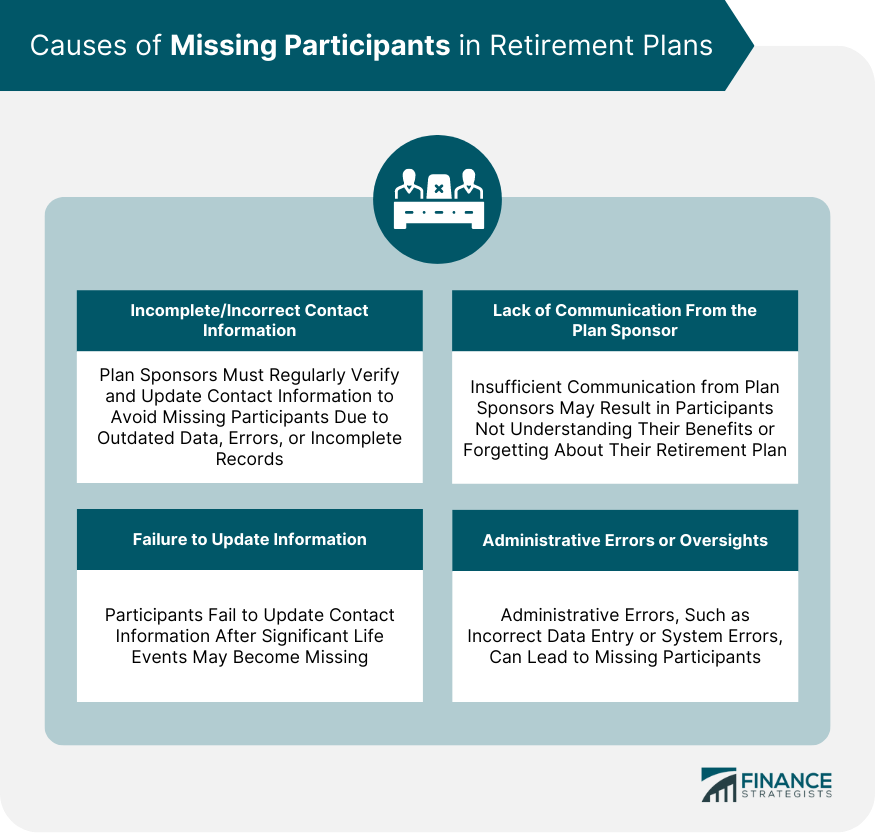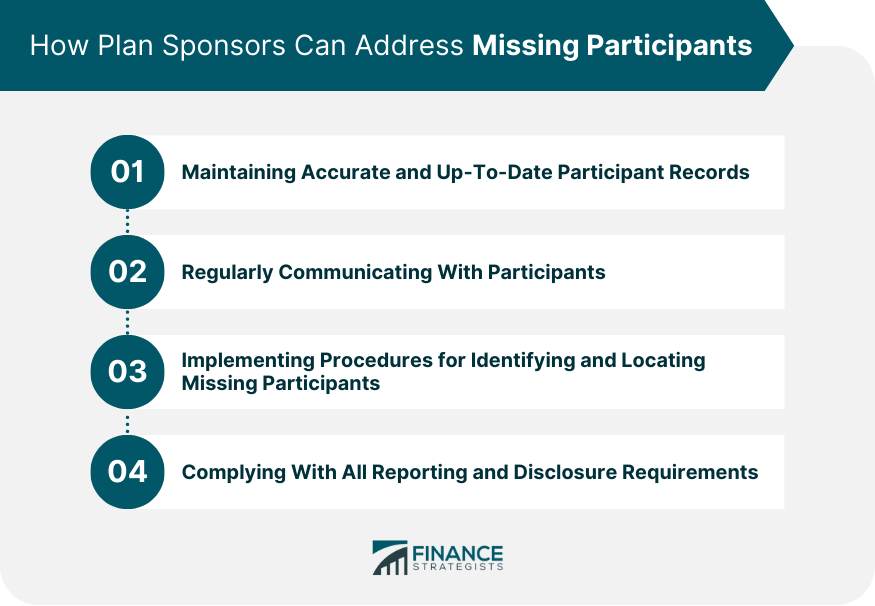A missing participant refers to a former employee or beneficiary who is entitled to retirement benefits but cannot be located by the plan sponsor or administrator. These individuals may have vested benefits in a retirement plan but have become unresponsive or unreachable for various reasons. Missing participants can create administrative challenges for plan sponsors and potentially expose them to legal and regulatory risks. Ensuring that all plan participants receive their entitled benefits is an essential aspect of retirement planning and compliance with the Employee Retirement Income Security Act (ERISA). Addressing missing participants is crucial for several reasons, including fulfilling fiduciary duties, maintaining plan compliance, and ensuring that participants receive their benefits. Unclaimed benefits can lead to regulatory scrutiny and potential penalties, making it essential for plan sponsors and administrators to proactively locate and communicate with missing participants. Moreover, finding missing participants and distributing their benefits helps strengthen the retirement system by ensuring that all participants have access to the funds they have earned. This enhances the overall effectiveness and fairness of the retirement planning process. A missing participant may be a former employee who has changed jobs, a beneficiary who has moved without updating their contact information, or an individual who has become unresponsive to plan communications. In general, a missing participant is someone who is owed benefits but is not currently in contact with the plan sponsor or administrator. Identifying missing participants can be challenging, as they may not be aware that they have unclaimed benefits or may have forgotten about their retirement plan. Therefore, plan sponsors and administrators must make a concerted effort to locate and communicate with these individuals. The Department of Labor (DOL), Internal Revenue Service (IRS), and the Pension Benefit Guaranty Corporation (PBGC) have established guidelines and regulations concerning missing participants in retirement plans. These agencies require plan sponsors to undertake diligent efforts to locate missing participants and distribute their benefits. ERISA also imposes fiduciary duties on plan sponsors and administrators, requiring them to act in the best interests of plan participants. This includes taking appropriate steps to locate missing participants and ensure that they receive their entitled benefits. One of the primary causes of missing participants is incomplete or incorrect contact information in plan records. This can result from data entry errors, outdated information, or incomplete records. To minimize the risk of missing participants, plan sponsors should regularly update and verify contact information, ensuring that they have accurate records for all plan participants and beneficiaries. Participants may become missing when they fail to update their contact information after a significant life event, such as a change of address, marriage, or job transition. Plan sponsors and administrators should remind participants to update their contact information periodically and provide convenient methods for doing so. Additionally, plan sponsors can implement procedures to verify participant contact information during regular plan operations, such as during annual enrollment or benefit statements. A lack of communication from the plan sponsor can contribute to the issue of missing participants. Inadequate or infrequent communication may result in participants not understanding their benefits or forgetting about their retirement plans. Plan sponsors should establish clear, regular communication channels with participants, keeping them informed of their benefits and any relevant plan updates. Administrative errors or oversights can lead to missing participants. These may include incorrect data entry, system errors, or miscommunication between plan administrators and employers. To prevent these issues, plan sponsors should establish robust record-keeping and administrative processes, ensuring that participant information is accurate, complete, and up-to-date. Various search methods can be employed to locate missing participants, ranging from simple techniques, such as mailing letters to the last known address, to more advanced methods, such as using professional locator services. The most effective approach will depend on the specific circumstances and resources available to the plan sponsor. By understanding and utilizing a range of search methods, plan sponsors can increase their chances of locating missing participants and fulfilling their fiduciary responsibilities. Common search methods for missing participants include mailing letters to the last known address, attempting contact via telephone or email, using internet search tools or social media, and employing professional locator services or credit reporting agencies. Additionally, plan sponsors can use resources such as the National Change of Address (NCOA) database, the Social Security Administration's letter-forwarding service, or the PBGC's missing participant program to help locate missing participants. Each search method has its advantages and disadvantages. For example, mailing letters to the last known address can be a low-cost approach but may not be effective if the participant has moved multiple times. Professional locator services can be more successful in locating missing participants but may come with higher costs. Plan sponsors should weigh the pros and cons of each method and select the most appropriate combination of search techniques for their specific situation. Best practices for plan sponsors include maintaining accurate and up-to-date participant records, regularly communicating with participants, implementing procedures for identifying and locating missing participants, and complying with all reporting and disclosure requirements. By adopting these best practices, plan sponsors can mitigate the risks associated with missing participants and ensure that all participants receive their entitled benefits. Plan sponsors should be aware of the legal considerations surrounding missing participants, including their fiduciary duties under ERISA and potential liability for failing to locate and distribute benefits. Working with legal counsel or ERISA consultants can help plan sponsors navigate these complexities and maintain compliance with all applicable laws and regulations. Missing participants in retirement plans are former employees or beneficiaries who are entitled to retirement benefits but cannot be located by the plan sponsor or administrator. Various search methods can be employed to locate missing participants, ranging from simple techniques to more advanced methods, and each method has its advantages and disadvantages. Additionally, plan sponsors can adopt best practices for maintaining accurate and up-to-date participant records, regularly communicating with participants, implementing procedures for identifying and locating missing participants, and complying with all reporting and disclosure requirements. Finally, plan sponsors should be aware of the legal considerations surrounding missing participants, including their fiduciary duties under ERISA and potential liability for failing to locate and distribute benefits. By staying informed and adapting their strategies and processes accordingly, plan sponsors can better address the issue of missing participants and ensure compliance with all applicable requirements.Definition of Missing Participant
Importance of Missing Participants in Retirement Planning
What Constitutes a Missing Participant
Regulatory Framework Around Missing Participants
Causes of Missing Participants
Incomplete or Incorrect Contact Information
Failure to Update Information
Lack of Communication From the Plan Sponsor
Administrative Errors or Oversights

Search Methods for Missing Participants
Overview of Different Search Methods
Detailed Explanation of Methods Commonly Used
Pros and Cons of Different Search Methods
Strategies to Address Missing Participants
Best Practices for Plan Sponsors

Legal Considerations
Conclusion
Missing Participant FAQs
A missing participant is a participant in a retirement plan who cannot be located, usually due to incomplete or incorrect contact information.
Common causes of missing participants include incomplete or incorrect contact information, failure to update information, lack of communication from the plan sponsor, and administrative errors or oversights.
Addressing missing participants is important because it can negatively impact retirement plans, result in fiduciary liability, and violate regulatory requirements.
Search methods for locating missing participants include using certified mail, checking related plan and employer records, using internet search tools, and using commercial locator services.
Strategies for addressing missing participants include implementing best practices for plan sponsors, staying up to date on regulatory requirements, and considering legal advice and guidance.
True Tamplin is a published author, public speaker, CEO of UpDigital, and founder of Finance Strategists.
True is a Certified Educator in Personal Finance (CEPF®), author of The Handy Financial Ratios Guide, a member of the Society for Advancing Business Editing and Writing, contributes to his financial education site, Finance Strategists, and has spoken to various financial communities such as the CFA Institute, as well as university students like his Alma mater, Biola University, where he received a bachelor of science in business and data analytics.
To learn more about True, visit his personal website or view his author profiles on Amazon, Nasdaq and Forbes.











